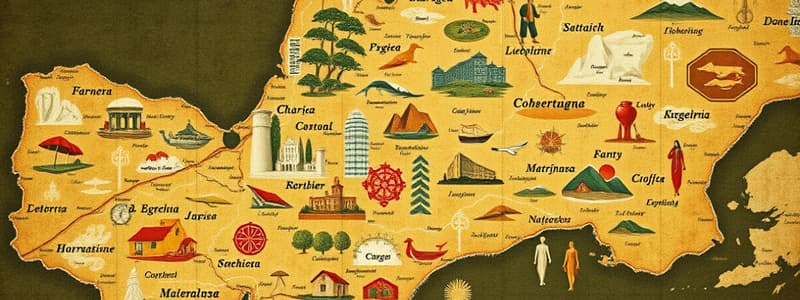Podcast
Questions and Answers
A map key, also known as a ______, explains the symbols and colors used on a map.
A map key, also known as a ______, explains the symbols and colors used on a map.
legend
Different ______ on a map may indicate various geographical features, like blue for water.
Different ______ on a map may indicate various geographical features, like blue for water.
colors
The ______ on a map indicates the relationship between distances on the map and actual distances on the ground.
The ______ on a map indicates the relationship between distances on the map and actual distances on the ground.
scale
A north arrow included in a map key is used for ______.
A north arrow included in a map key is used for ______.
Map keys enhance ______ for users unfamiliar with the region or lacking map-reading skills.
Map keys enhance ______ for users unfamiliar with the region or lacking map-reading skills.
Flashcards are hidden until you start studying
Study Notes
Visualizing Map Keys
- Definition: A map key, or legend, explains the symbols and colors used on a map.
- Components:
- Symbols: Icons representing physical features (e.g., mountains, rivers) or man-made structures (e.g., roads, buildings).
- Colors: Different shades may indicate various geographical features (e.g., blue for water, green for vegetation).
- Scale: Indicates the relationship between distances on the map and actual distances on the ground.
- Orientation: Usually includes a north arrow to show direction.
Importance of Map Keys
- Understanding: Enables users to interpret and understand the information presented on the map.
- Navigation: Facilitates accurate navigation by clarifying symbols and features.
- Communication: Provides a universal language for map reading, allowing users to share and convey geographical information.
- Data Representation: Helps visualize complex data sets, such as population density or resource distribution.
- Accessibility: Enhances accessibility for users unfamiliar with the region or lacking map-reading skills.
Visualizing Map Keys
- A map key, also known as a legend, explains the symbols and colors that appear on a map.
- Symbols represent physical features like mountains and rivers, as well as man-made structures such as roads and buildings.
- Colors on maps employ various shades to denote different geographical features, with blue commonly representing water and green indicating vegetation.
- Scale on a map explains the relationship between map distances and actual ground distances, aiding in understanding measurement.
- An orientation feature, typically a north arrow, shows direction, crucial for navigation.
Importance of Map Keys
- Understanding map keys allows users to accurately interpret the information conveyed through the map.
- Enhanced navigation is achieved as map keys clarify symbols and features, enabling users to traverse areas confidently.
- Map keys provide a universal language for map reading, allowing effective communication and sharing of geographical insights among users.
- Complex data sets, such as population density or resource distribution, can be visualized more clearly through the effective use of map keys.
- Accessibility is improved for individuals unfamiliar with a region or those who may not possess strong map-reading skills, making geographical information more approachable.
Studying That Suits You
Use AI to generate personalized quizzes and flashcards to suit your learning preferences.




